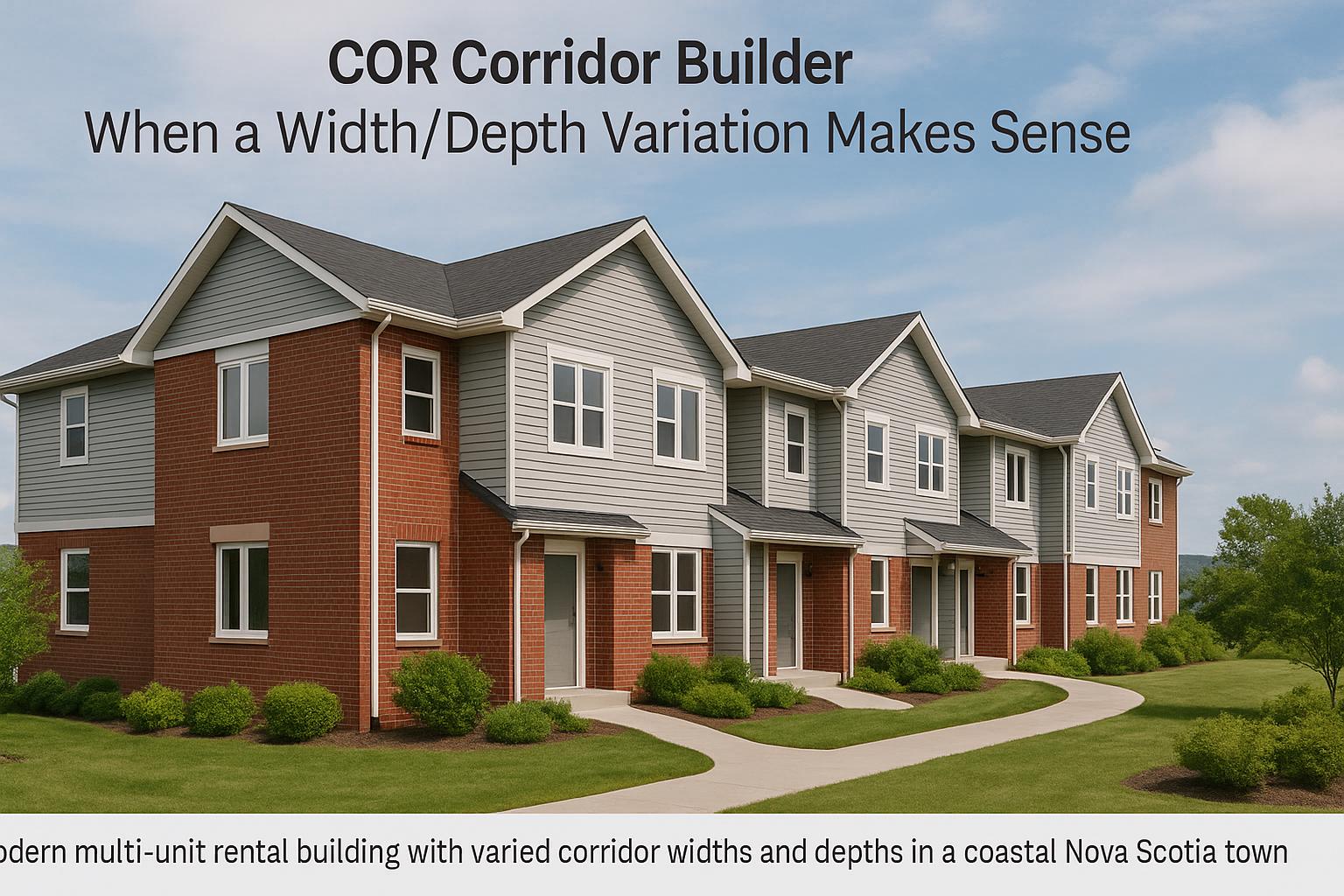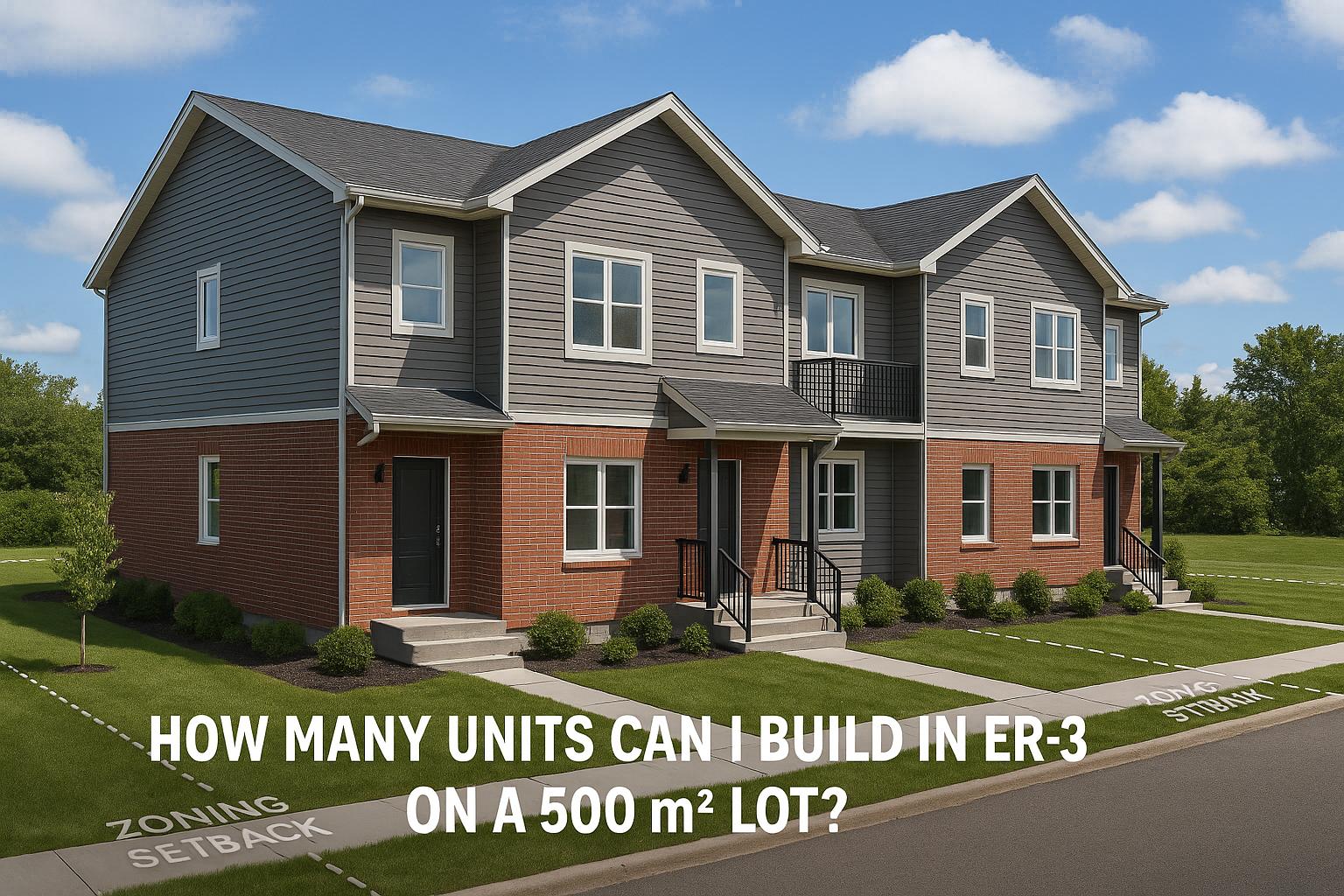CEN-2 zoning in Nova Scotia allows for high-density, multi-use developments while prioritizing pedestrian-friendly design. Key rules include limits on podium height (11m), step-backs for upper floors (minimum 3m), and restrictions on façade length (64m). Developers can achieve Floor Area Ratios (FAR) of up to 8.00 and building heights of 90m while maintaining a human-scale street presence.
To maximize rentable space without compromising street-level appeal:
- Use step-backs for terraces or outdoor spaces.
- Design engaging façades with varied materials, balconies, and windows.
- Activate ground floors with transparent façades, multiple entrances, and landscaping.
An integrated design-build approach simplifies construction, ensuring zoning compliance, cost predictability, and faster timelines. This method delivers better financial outcomes, with projects often achieving annual returns of 12–20% and higher tenant demand. Smart podium and façade strategies enhance property value and rental performance in competitive markets.
Design of Wood-Over-Concrete Podium Structures
Key Zoning Rules That Shape Podium and Façade Design
CEN-2 zoning lays out clear guidelines that directly shape the design of a building's podium and façade, aiming to balance higher density with a welcoming, pedestrian-friendly environment. Here's a closer look at how these rules influence design choices.
CEN-2 Zoning Requirements for Podiums and Façades
When it comes to podiums, CEN-2 zoning sets specific parameters. For instance, the maximum streetwall height is capped at 11.0 metres (around three storeys) to maintain a human-scale, pedestrian-friendly base [1]. To reduce the visual bulk of the building, a minimum 3.0-metre step-back is required above this height.
Façades also have their own design constraints. Podium faces can't exceed 64 metres in length, which encourages variation in the building's appearance. Additionally, streetwall step-backs must occur at 8-metre intervals, creating regular visual breaks. These breaks allow for features like balconies, windows, and entrances, which make the streetfront more engaging. Front yard setbacks can be as little as 0.0 metres, enabling buildings to align with the property line and strengthen the connection to the street [1].
Design Limits and Opportunities
While CEN-2 zoning imposes certain limits, it also opens up opportunities for creative design. Developers can achieve a Floor Area Ratio (FAR) between 2.25 and 8.00, with buildings reaching heights of up to 90 metres (approximately 29 storeys) [1]. Above the podium, the rules for the tower portion are even more specific: the maximum building face length is restricted to 35 metres, and floor plates can't exceed 750 m². These measures ensure towers appear slender and less imposing from the street while still offering substantial rentable space.
Setbacks also play a crucial role in shaping the overall design. Side yard setbacks must be at least 3.0 metres, unless the building is adjacent to another CEN zone, where a 0.0-metre setback is allowed. For towers near CEN, Downtown, or University zones, a 6-metre setback is required from the side and rear lot lines [1]. Together, these rules create a framework that allows for high-density development while ensuring the streetscape remains inviting and accessible for pedestrians.
Design Methods to Maximize GFA While Keeping Human-Scale
CEN-2 zoning encourages designs that maximize rentable Gross Floor Area (GFA) while maintaining an inviting, human-scale presence at street level. By working within these guidelines, developers can achieve both financial goals and community-friendly designs.
Step-Backs: Balancing Height and Street Appeal
Step-backs are a key tool for keeping tall buildings from feeling overwhelming at street level. By incorporating breaks in the building's massing at specific heights, step-backs help align with podium and setback rules while softening the visual impact of taller structures. These breaks can also double as opportunities for terraces, outdoor amenities, or green roofs, which enhance the building’s appeal to tenants.
To make the most of the available space, align the podium with the property boundary before introducing a step-back. This ensures the lower levels maximize rentable area while meeting zoning requirements. Terraced step-backs, when thoughtfully designed, can create outdoor spaces that add value throughout the building’s height. What starts as a regulatory necessity can become a desirable feature for tenants, blending function with aesthetics.
Once the massing is in place, the next step is to refine the building’s appearance through façade design.
Façade Articulation and Material Choices
A thoughtfully designed façade breaks up the building’s mass, avoiding a bulky, monotonous look. This creates a more dynamic and visually interesting streetscape.
Using different materials at various levels can help establish a human-scale appearance. For instance, robust materials like brick or stone at the podium level create a sense of stability, while lighter materials such as metal panels or fibre cement on upper levels add a contemporary touch. Adding wood accents around entries or key features can bring warmth and a residential feel to the design.
Balconies and window placements also play a big role in façade articulation. Recessed balconies and projecting entryways add depth, breaking up flat surfaces without reducing rentable space. Subtle variations in colour and texture within a cohesive material palette can further enhance the façade, creating visual interest while maintaining a polished, unified look.
Ground-Level Activation and Streetscape Design
The ground floor serves as the building’s face to the community, influencing both compliance with zoning rules and tenant appeal. Transparent façades and expansive windows create an open, welcoming frontage, drawing attention to ground-level spaces.
Instead of relying on a single main entrance, consider adding multiple entry points along the façade. This approach avoids the institutional feel of single-entry designs and fosters a more residential rhythm. These entrances can be integrated with setback requirements, creating a seamless and inviting entry experience.
Landscaping plays a crucial role in softening the transition between the building and the sidewalk. Features like planting beds, decorative paving, or low boundary walls add character and help define the building’s base. Such design elements contribute to a strong first impression for prospective tenants.
Paying attention to grade-level details can elevate the overall tenant experience. High-quality entrance materials, integrated lighting, and weather protection - like covered walkways - enhance both functionality and aesthetics. Additional touches, such as built-in seating or bicycle storage areas, provide practical benefits while boosting visual appeal. When interior spaces flow naturally into thoughtfully designed exteriors, the result is a building that feels welcoming, liveable, and aligned with higher rental expectations. These details also support better occupancy rates, making them a win for both tenants and owners alike.
sbb-itb-16b8a48
Integrated Design-Build Approaches for Streamlined Construction
CEN-2 projects demand precise coordination between meeting design standards and executing construction tasks. When processes are fragmented, the result is often delays, budget overruns, and compromised quality. An integrated design-build approach brings all project phases under one umbrella, minimizing risks and speeding up completion. This unified method ensures smoother workflows from start to finish.
Benefits of Integrated Design-Build for CEN-2 Projects
Traditional construction methods often involve multiple contracts, which increases the likelihood of miscommunication and errors. In contrast, integrated design-build relies on a single point of accountability, with one company managing design, engineering, and construction. This unified team approach ensures that the intricate requirements of CEN-2 projects - such as podium designs, step-backs, and façade articulation - are addressed early on, aligning zoning compliance with construction realities. This avoids the common issue where detailed designs fail to translate effectively into the construction phase, leading to costly last-minute adjustments.
Fixed pricing is another advantage, giving property owners a clear understanding of costs before construction begins. This helps avoid the 30–60% cost overruns often seen in fragmented projects. Timelines are also more predictable. While traditional projects that should take roughly 8 months can stretch to over 18 months due to coordination issues, integrated teams use advanced scheduling tools to ensure all trades are aligned from the outset, delivering buildings on time.
Collaboration is key to maintaining quality. Instead of relying on builders to interpret architectural plans correctly, integrated teams work together continuously to ensure critical details - like step-back transitions and façade materials - are executed as intended. This results in a structure that meets CEN-2 zoning requirements while maintaining the appealing, human-scale design that attracts quality tenants.
Integrated vs. Fragmented Construction Comparison
| Factor | Integrated Design-Build | Fragmented Construction |
|---|---|---|
| Cost Control | Fixed pricing determined before construction begins | Cost-plus model with overruns averaging 30–60% |
| Timeline Certainty | 6-month guaranteed completion with financial penalties | Typically spans 8–18+ months with frequent delays |
| Accountability | One company oversees all phases | Multiple contracts often lead to blame shifting |
| CEN-2 Compliance | Unified team ensures zoning compliance from the start | Separate teams may cause compliance gaps |
| Quality Assurance | Collaboration ensures design intent is upheld | Handoffs increase the risk of misinterpretation |
| Communication | Single source provides daily updates | Owners must manage multiple relationships |
This comparison highlights why integrated design-build is particularly suited for CEN-2 projects. The approach is tailored to handle the zoning requirements for podium design and façade articulation. Integrated teams can make real-time adjustments to step-back details or material choices, avoiding expensive rework and delays. By seamlessly combining design accuracy with construction execution, these teams ensure that step-back transitions and façade elements meet both zoning standards and tenant expectations.
For property owners, choosing an integrated design-build model means less stress and better financial results. Fixed timelines and pricing eliminate the headaches of coordination chaos, allowing owners to focus on managing their properties instead of untangling construction issues.
Maximizing Project Value: Financial and Rental Impact
Designing in line with CEN-2 zoning standards isn't just about meeting regulations - it’s also a smart financial move. By focusing on integrated design-build methods, particularly with podium and façade strategies, property owners can elevate their projects' performance. Thoughtfully designed podiums and façades not only enhance the visual appeal but also create inviting, human-scale streetscapes that stand out in competitive markets. This attention to detail can significantly boost both market appeal and long-term financial returns.
Using high-quality materials, durable finishes, and energy-efficient features further strengthens a property’s value. While the specific advantages depend on the project, prioritizing well-crafted design is widely regarded as a winning strategy. It not only uplifts the overall property value but also attracts tenants who are willing to pay a premium for quality and comfort.
Local Market Data and ROI Benchmarks
Local market trends back up the financial benefits of optimized design. Take Helio Urban Development as an example: their two-bedroom rental units command monthly rents between $1,950 and $2,100. These projects have achieved annual returns ranging from 12% to 20%, showcasing the financial potential of well-executed designs. Properties with enhanced podiums and façades often enjoy a stronger market presence, which can also lead to higher resale values.
In addition to rental income and resale benefits, superior design can unlock financing perks. Projects that meet the standards of initiatives like CMHC MLI Select - which rewards energy efficiency and design excellence - can qualify for up to 95% financing with extended amortization periods. This type of financing not only improves cash flow but also provides opportunities for expanding property portfolios.
While financial outcomes will vary depending on the project and local market conditions, investing in quality podium and façade strategies for CEN-2 properties offers a tangible path to stronger rental performance and long-term asset growth.
Conclusion: Balancing Design, Compliance, and Profitability
Navigating CEN-2 zoning requirements to create profitable multi-unit developments hinges on the seamless integration of design, compliance, and construction methods. Property owners who focus on maximizing Gross Floor Area (GFA) through smart podium and façade strategies can achieve both short-term rental success and long-term value growth.
Using an integrated design-build approach simplifies the process by combining design, engineering, and construction into one cohesive system. This eliminates coordination issues that often lead to cost overruns and delays in traditional construction projects. By aligning all professionals under one roof, this method ensures that podium design, façade details, and GFA optimization are addressed cohesively from the outset. Design challenges are resolved early, helping to maintain the $160,000 per unit budget and stick to the six-month timeline.
The benefits of this approach go beyond just construction efficiency. Thoughtfully designed podiums and façades not only enhance the visual appeal of a development but also attract higher rents without compromising on usable space. This balance supports annual returns in the range of 12-20%, making multi-unit projects a solid financial opportunity for property owners.
Additionally, the fixed-price contracts and guaranteed timelines inherent in the integrated design-build model provide cost and schedule predictability. This level of certainty allows property owners to confidently plan their rental income and strategize future portfolio growth.
Ultimately, success in CEN-2 zoning projects comes down to execution. Property owners who adopt integrated design-build methods consistently deliver superior results in design, compliance, and financial performance compared to traditional, fragmented construction approaches.
FAQs
What are the specific advantages of using an integrated design-build approach for CEN-2 projects compared to traditional construction methods?
The design-build approach brings a host of benefits to CEN-2 projects by fostering close collaboration between architects, engineers, and builders from the outset. This method simplifies communication, accelerates project timelines, and ensures that both the design and construction phases work seamlessly together to align with zoning regulations while preserving a human-scale aesthetic.
In contrast to traditional construction methods - where teams often work in silos and multiple contracts can complicate accountability - the design-build model offers property owners a single point of responsibility. This not only helps keep costs predictable but also reduces delays and boosts overall project quality. For multi-unit residential projects like CEN-2, this approach is a practical and effective way to combine architectural appeal with zoning compliance and financial viability.
How can property owners design buildings under CEN-2 zoning to keep a human-scale appearance while maximizing Gross Floor Area (GFA)?
To keep a human-scale design while making the most of the Gross Floor Area (GFA) allowed under CEN-2 zoning, property owners can adopt several architectural approaches. These include using step-backs to soften the appearance of upper floors, adding façade articulation with varied textures and shapes to make the exterior more engaging, and choosing materials that bring warmth and character to the building.
These strategies help ensure the structure remains inviting and pedestrian-friendly. At the same time, they allow property owners to meet zoning rules and maximize usable space. The result? Developments that are both practical and visually appealing, contributing positively to the neighbourhood's overall look and feel.
What are the financial benefits of using high-quality materials and energy-efficient features in CEN-2 zoned multi-unit buildings?
Using durable materials and energy-efficient features in CEN-2 zoned developments can lead to noticeable financial perks. For one, lower energy consumption translates to reduced utility bills, cutting down on operating costs and making your property easier to maintain in the long run.
On top of that, energy-efficient designs and long-lasting materials can increase the value of your property. They also appeal to tenants who are mindful of sustainability and want to save on utilities. This combination not only improves your bottom line but also helps your property stand out in a crowded rental market.



